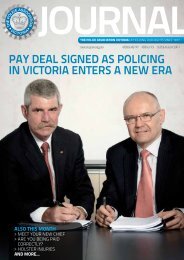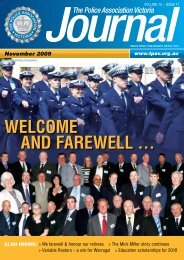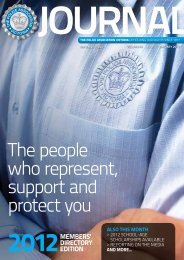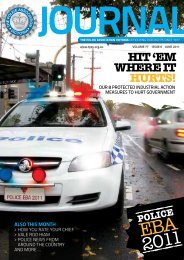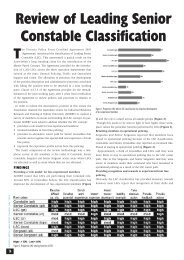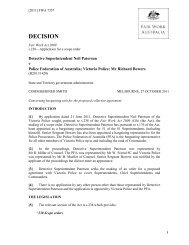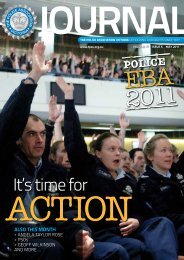August 2009 - The Police Association Victoria
August 2009 - The Police Association Victoria
August 2009 - The Police Association Victoria
Create successful ePaper yourself
Turn your PDF publications into a flip-book with our unique Google optimized e-Paper software.
13<br />
that declaration is made. Unified<br />
command and control, with a single<br />
person in charge, may have made a<br />
very real difference.<br />
If the 7 th of February <strong>2009</strong>,<br />
being the worst natural disaster<br />
in Australia’s history, was not an<br />
appropriate time to declare a state if<br />
disaster, one wonders exactly what<br />
situation the legislation contemplates.<br />
<strong>The</strong>se issues deserve clarity if the<br />
public of <strong>Victoria</strong> are to ever know<br />
the truth.<br />
<strong>The</strong> <strong>Police</strong> <strong>Association</strong> has<br />
addressed some of these issues<br />
in its submission to the Royal<br />
Commission. <strong>The</strong> submission<br />
was prepared after TPA asked for<br />
feedback from members on three key<br />
issues: communications, resources<br />
and command & control. <strong>Police</strong><br />
<strong>Association</strong> Secretary Greg Davies<br />
addressed the key communications<br />
issues in a newsletter in July.<br />
Greg says a “glaring omission”<br />
from the commission hearings<br />
so far is the failure to call former<br />
Chief Commissioner Christine<br />
Nixon in her role as the State<br />
Emergency Response Co-ordinator<br />
and the <strong>Police</strong> Minister in his role as<br />
Co‐ordinator in Chief.<br />
He said, “Fire warnings have become<br />
an absolutely critical issue. <strong>The</strong> law says<br />
the <strong>Victoria</strong> <strong>Police</strong> has responsibilities<br />
for warnings. We need to know why a<br />
State of Emergency was not called. It is<br />
difficult to see how the commission can<br />
come to any conclusions on how the<br />
system failed <strong>Victoria</strong> without hearing<br />
directly from the two most senior people<br />
responsible for emergencies.”<br />
So – we are all aware of who was<br />
supposed to be in charge.<br />
<strong>The</strong> $64 question now is,<br />
“Who was?”<br />
Member’s are invited to read the<br />
<strong>The</strong> <strong>Police</strong> <strong>Association</strong>’s submission<br />
to the <strong>2009</strong> <strong>Victoria</strong>n Bushfires Royal<br />
Commission in its entirety on our<br />
website – www.tpav.org.au<br />
<strong>The</strong> <strong>Police</strong> <strong>Association</strong> has made the following<br />
recommendations to the Bushfire Royal Commission.<br />
1. Funding of ESTA in rural <strong>Victoria</strong>. Funding must be made<br />
available immediately to move all “country D24” centres to the ESTA<br />
facility at Ballarat and provide CAD facilities. Funds must also be<br />
made available to replace the country analogue radio network with a<br />
digital network capable of communicating with the metropolitan radio<br />
network and other emergency services.<br />
2. Co-location of Emergency Services. When responding to<br />
emergencies such as the fires of 7 February <strong>2009</strong>, <strong>Police</strong> and fire<br />
fighting authorities should, at all levels, be located together to facilitate<br />
timely communication and co-ordination.<br />
3. Alignment of Geographic Areas. <strong>Police</strong>, CFA and DSE<br />
geographic areas should be aligned.<br />
4. Alignment of Agency Structures. <strong>The</strong> internal structures of<br />
the CFA, DSE and <strong>Police</strong> for response to fires must comply with the<br />
framework in the Act and the Manual.<br />
5. Clear Statutory Responsibility. <strong>The</strong> scope and content of the<br />
roles designated by the Act and the Manual should be explicitly and<br />
unambiguously set out5. <strong>The</strong> responsibility of the State Emergency<br />
Coordinator of DISPLAN to actively check the timing, content and issue<br />
of warnings, including advice to evacuate (currently implicit) should be<br />
made explicit.<br />
6. Strict Statutory Compliance. Those assuming roles under the<br />
Act should actively fulfill them and only delegate their responsibilities<br />
as expressly provided in the Act and Manual. If a role is delegated, the<br />
delegator should provide a detailed written description to the delegatee<br />
of the scope and responsibilities of the delegated role.<br />
7. Communication of timely and detailed information.<br />
Communication to the public of timely information about fires<br />
detailing their location, intensity, size, direction and speed of travel,<br />
and expected changes in these elements together with weather reports<br />
and forecasts should properly form the basis of adequate warnings.<br />
Details of what people in the path of a fire can expect and strategies<br />
which they ought to adopt, or at least consider, should be incorporated<br />
into any public messages. Members of the public must be urged to<br />
maintain battery operated radios in order to receive warnings in the<br />
event of power failure.<br />
8. Warnings must provide useful and relevant content. If<br />
warnings include advice to evacuate, then the message should also<br />
include a time frame for safe departure from the area under threat.<br />
Such advice must also make reference to routes for evacuation and<br />
rallying points/refuges. <strong>The</strong> critical nature of such advice means that<br />
it must come from a credible source. <strong>The</strong> most appropriate source<br />
is <strong>Victoria</strong> <strong>Police</strong>. <strong>The</strong> formulation of fire warnings is appropriately<br />
the purview of the CFA (being the organization with the best access<br />
to detailed information about fires). That the police are required<br />
to actively check the appropriateness of the warnings provides a<br />
useful safeguard. To the extent that this system is in place it should<br />
be retained; to the extent that it is not, it should be implemented.<br />
Such a strategy requires Emergency Coordinators to become far more<br />
enmeshed in the response to fires.<br />
9. Clarification of Roadblock protocols. <strong>Police</strong> should be provided<br />
with unambiguous instructions detailing who can pass and re-pass<br />
roadblocks. <strong>The</strong> classes of people who are to be permitted to pass<br />
roadblocks must be identified clearly. A simple and reliable method<br />
of identifying those with permission to pass must be established to<br />
facilitate police performing their duty.<br />
10. Warnings and protection for police in fire affected areas.<br />
<strong>Police</strong> working in fire affected areas should be informed of all warnings<br />
at least at the same time as the public through the police radio and<br />
computer network. This is necessary for the safety of both the public<br />
and police members themselves. <strong>Police</strong> stations should be fire resistant<br />
and provide fire suppression equipment.<br />
www.tpav.org.au <strong>The</strong> <strong>Police</strong> <strong>Association</strong> Journal <strong>August</strong> <strong>2009</strong>



